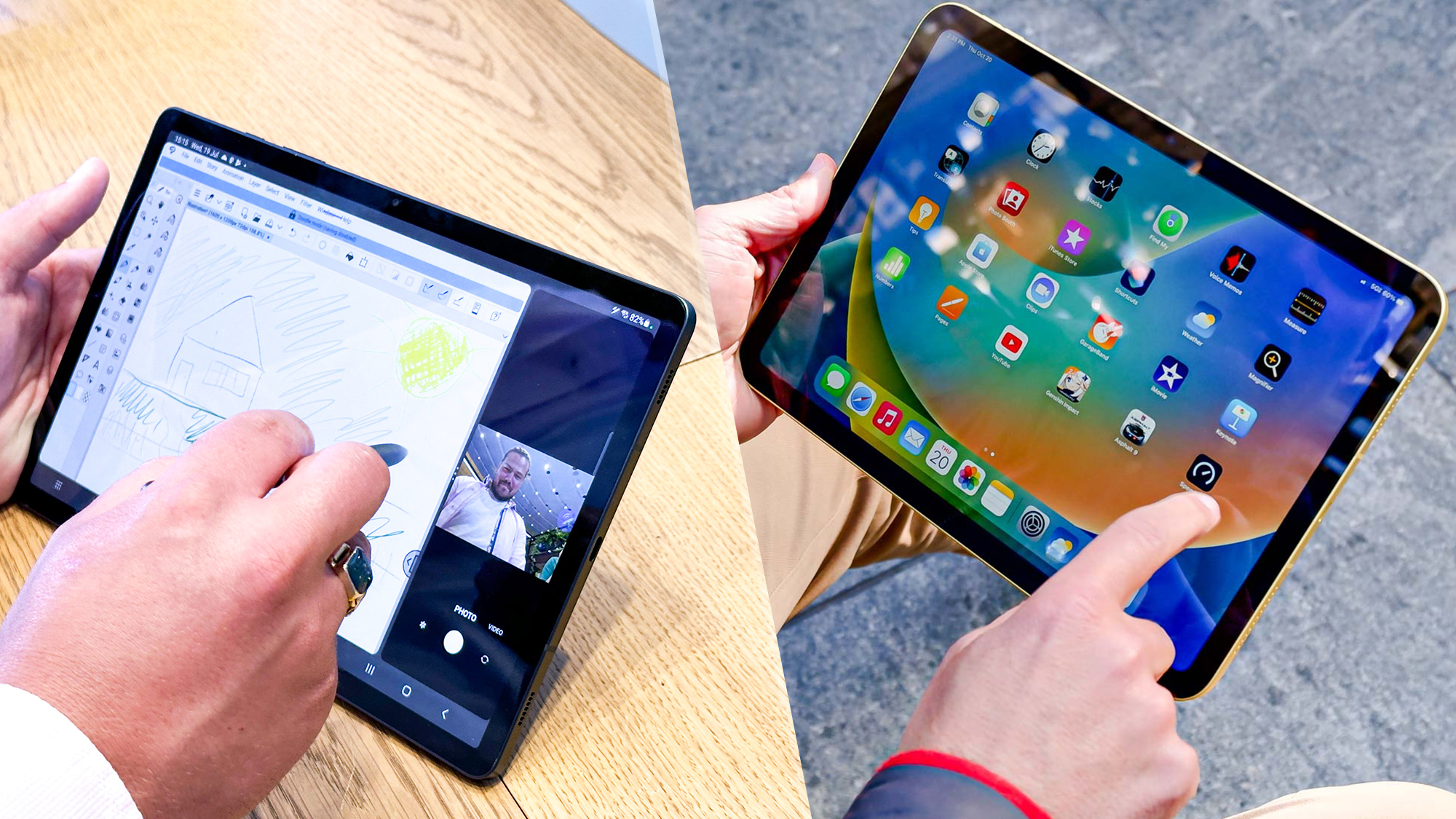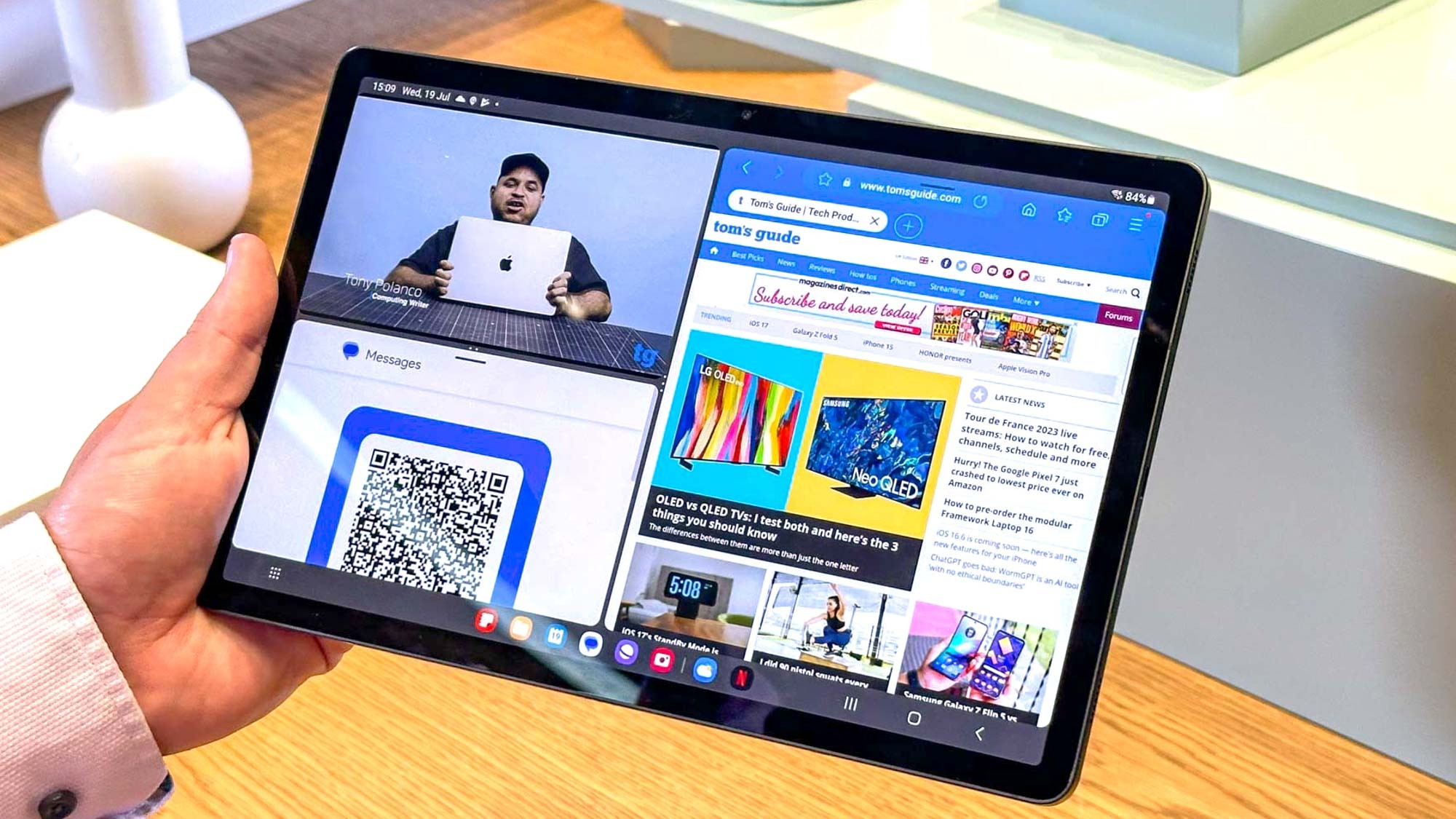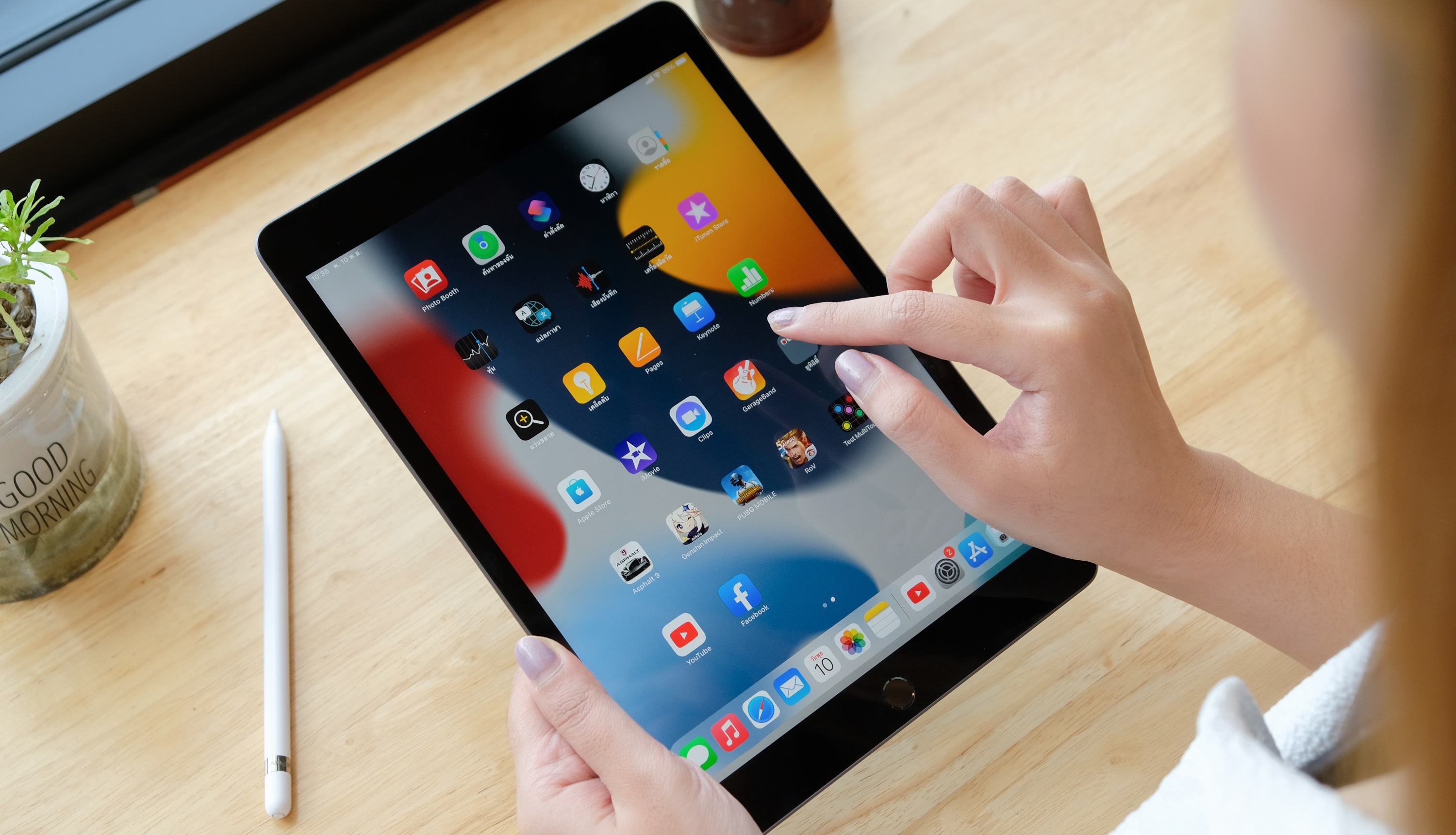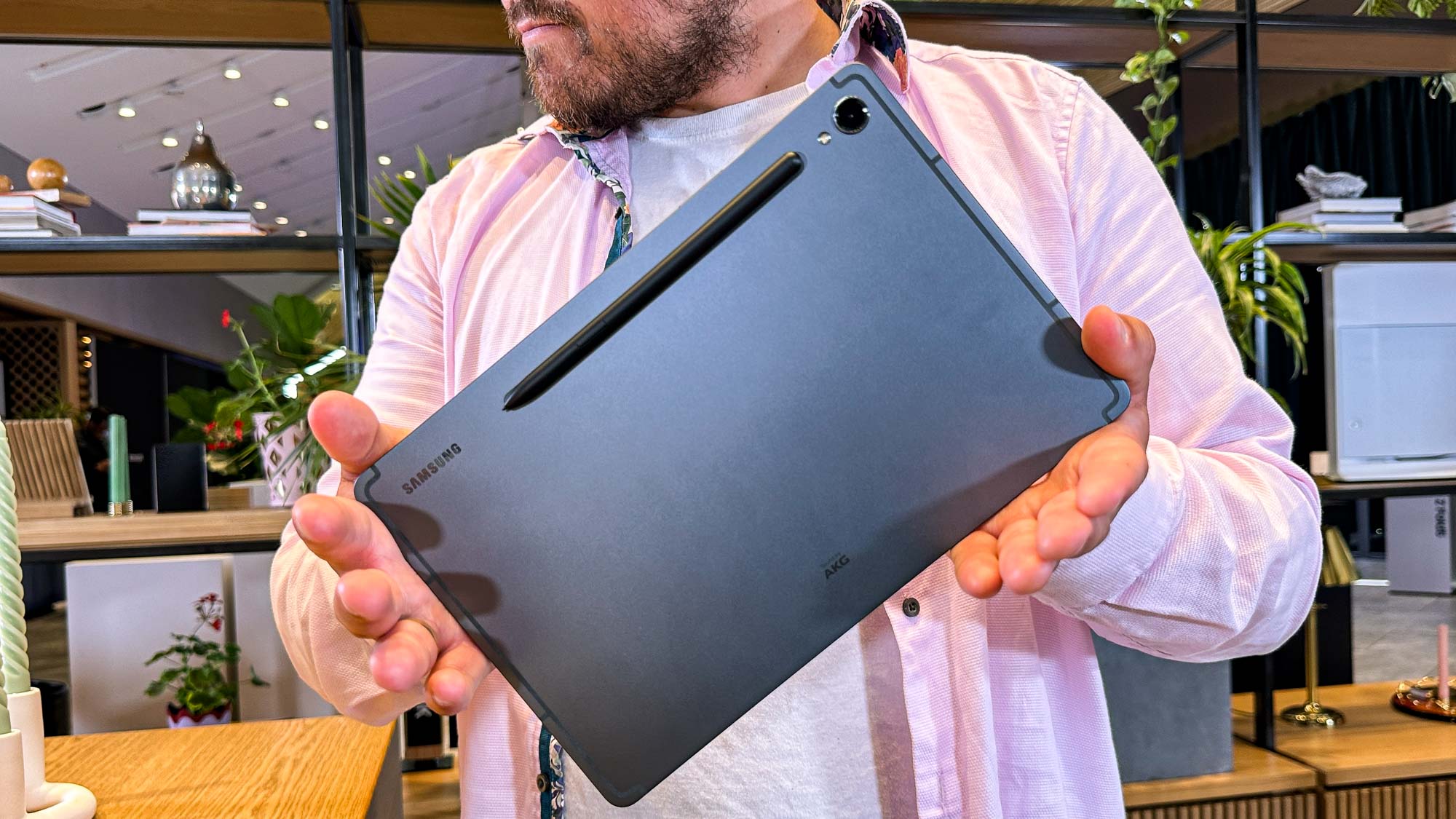Samsung Galaxy Tab S9 vs iPad (10th gen) — which tablet could win?
Does the Samsung Galaxy Tab S9 have what it takes to potentially beat the iPad 10th gen?

The Samsung Galaxy Tab S9 might be an entry-level Samsung slate, but it’s arguably received the most significant update compared to the Samsung Galaxy Tab S9 Plus and Samsung Galaxy Tab S9 Ultra.
Now that it sports an OLED panel like its beefier siblings, the Galaxy Tab S9 is effectively a premium product that won’t break the bank. In addition to its new panel, the Galaxy Tab S9 also packs the same Qualcomm Snapdragon 8 Gen 2 processor found in the company’s own Galaxy S23 smartphones.
The tablet also has 20% larger speakers and is IP68-rated for dust and water resistance. So far, the Galaxy Tab S9 has the makings to be included in our best Android and best Samsung tablets lists — just like its predecessor, the Samsung Galaxy Tab S8.
We’ve yet to test Samsung’s Galaxy Tab S9 tablet, but based on our hands-on time with the slate and everything else the company has announced, we have enough information to reasonably compare its features to its direct rival: the Apple iPad 10th gen.
Let’s pit Samsung and Apple’s entry-level tablets to see which could be the best slate for you.
Samsung Galaxy Tab S9 vs iPad (10th gen): Specs
| Header Cell - Column 0 | Samsung Galaxy Tab S9 (starting) | iPad 10th gen (starting) |
|---|---|---|
| Price | $799 | $449 |
| OS | Android 13 | iPadOS 16 (pre-installed) |
| CPU | Snapdragon 8 Gen 2 | A14 Bionic |
| RAM | 8GB, 12GB | 4GB |
| Storage | 128GB-256GB | 64GB, 256GB |
| Display | 11 inch OLED (2,560 x 1,600), 60-120Hz | 10.9-inch (2,360 x 1,640) |
| Ports | Thunderbolt 4/USB-C | USB-C |
| Rear Cameras | 13MP AF | 12MP |
| Front Cameras | 12MP UW | 12MP with 122-degree FOV |
| Battery Life | N/A | 10:57 (tested) |
| Size | 10.01 x 6.53 x 0.23 inches | 9.79 x 7.07 x 0.28 inches |
| Weight | 1.10 pounds | 1.05 pounds |
Samsung Galaxy Tab S9 vs iPad (10th gen): Price
The Samsung Galaxy Tab S9 is now available to pre-order starting at $799, with availability starting August 11. This model packs 128GB of storage and 8GB of RAM. You can configure the tablet with up to 12GB of RAM and 256GB of storage.
The iPad (10th gen) starts at $449, or $599 If you'd like 5G cellular connectivity. For that, you still get a rather stingy 64GB of storage. There's the option to upgrade to a much roomier 256GB, but that'll cost you an extra $150 on either model.
Get instant access to breaking news, the hottest reviews, great deals and helpful tips.
Apple’s products generally tend to be more expensive than its rivals, but in this instance, even the pricier 5G iPad is still $200 less than the Galaxy Tab S9. If you want to save money, then the iPad 10th gen is the tablet to get.
Samsung Galaxy Tab S9 vs iPad (10th gen): Design
At 10.01 x 6.53 x 0.23 inches and a weight of 1.10 pounds, the Galaxy Tab S9 is almost indistinguishable from its predecessor in terms of size and weight. It’s an elegant slab of aluminum that feels sturdy and great to hold. Given its slim profile and lightweight, you should be able to comfortably hold this tablet for long stints.

As before, there’s a slight bump on the back of the device that houses the rear camera, along with a magnetized strip where you attach and charge the S Pen. There’s a lone USB-C port along the bottom edge, while the left edge has a port for attaching the Book Cover Keyboard Slim. The power button, volume rocker and microSD card slot all reside on the tablet’s right edge. There’s no headphone jack anywhere in sight.
Measuring 9.79 x 7.07 x 0.28 inches and weighing 1.05 pounds (1.06 pounds for cellular), by comparison, the iPad (10th gen) is smaller and lighter than the Galaxy Tab S9. Apple expanded the iPad’s display from 10.2 inches to 10.9 inches and discarded the old Home button. That results in a screen that nearly goes edge to edge, though the bezels are still very much noticeable. Another plus is that the iPad’s Power button has Touch ID built in, so you just need to rest your finger on the button to unlock the iPad.

Apple spiced things up with the iPad's colors. We reviewed the yellow model, which is quite bold and is a cross between yellow and gold. You can also pick pink, blue and silver.
Both tablets are stylish, slim and lightweight. The iPad is slightly smaller and lighter than Samsung’s slate but not by much. Design is subjective, but given how identical the tablets are to one another, neither is a clear winner or loser.
Samsung Galaxy Tab S9 vs iPad (10th gen): Display
Since we don’t yet have the Galaxy Tab S9 in for testing, we can’t yet compare its display to that of the iPad’s. This is especially true since the new Tab S9 has an 11-inch OLED panel compared to the Tab S8’s LCD — meaning we can’t use those previous test results to give us an idea of what to expect in terms of brightness, color accuracy, and color saturation.
That said, let’s take a look at the iPad 10th gen’s display to see what the Galaxy Tab S9 has to contend with.
| Header Cell - Column 0 | iPad 10th gen |
|---|---|
| Nits (brightness) | 504 |
| sRGB | 101.2% |
| DCI-P3 | 71.7% |
| Delta-E | 0.21 |
On our lab tests, the iPad 2022 registered a max of 504 nits of brightness, which just about matches Apple’s 500-nit claim. That’s not bad but we had some trouble viewing the panel in direct sunlight.
In terms of colors, the iPad’s display covered 101.2% of the sRGB color gamut and 71.7% of the more demanding DCI-P3 color space. The iPad Air’s panel hit a higher 111.8% and 79.2%, respectively. In the Delta-E color accuracy test (where lower numbers are better), the iPad scored 0.21.
Samsung Galaxy Tab S9 vs iPad (10th gen): Performance
All three Galaxy Tab S9 devices run on the Snapdragon 8 Gen 2 processor compared to the Snapdragon 8 Gen 1 chip the Tab S8 series ran on. Conversely, the Apple iPad 10th gen utilizes the company’s A14 Bionic chip.
I’m using Snapdragon 8 Gen 2 benchmarks for reference below, but note that these results aren’t indicative of the Galaxy Tab S9’s true performance.
| Header Cell - Column 0 | Single-core | Multi-core |
|---|---|---|
| Snapdragon 8 Gen 2 | 1,500 | 5,249 |
| iPad 10th gen (A14 Bionic) | 1,580 | 4,400 |
On Geekbench 5, which measures overall performance, the iPad 2022 scored 1,580 on single-core and 4,400 on multi-core. The Qualcomm Snapdragon 8 Gen 2 reference design device we benchmark scored 1,500 and 5,249 (respectively) in the same tests.
We’ll have a full performance comparison once we test the Galaxy Tab S9, but if our Snapdragon 8 Gen 2 benchmarks are any indication, it seems the Galaxy Tab S9 could outperform the A14 Bionic-driven iPad 10th gen, at least in the multi-core portion of our test. I’ll need to use both devices to see if there’s any substantial difference during real-world usage.
Samsung Galaxy Tab S9 vs iPad (10th gen): Battery life
As with display and performance, we can’t do a proper battery life comparison between the two tablets until we’ve tested the Galaxy Tab S9.
That said, the Tab S9 features a 8,400mAh battery compared to the Galaxy Tab S8’s 8,000mAh battery. That could potentially improve its battery life over its predecessor, but it’s also possible the OLED display and stronger processor could effectively nullify any battery gains. In that sense, the Galaxy Tab S9 could have comparable battery life to its predecessor, though that’s conjecture on my part.
| Header Cell - Column 0 | Time (hours:mins) |
|---|---|
| Galaxy Tab S8 | 12:52 |
| iPad 10th gen | 10:57 |
Speaking of the Galaxy Tab S8, it lasted for an epic 12 hours and 52 minutes in our battery test, which involves continuous web surfing at 150 nits of brightness. In comparison, the iPad 10th gen lasted for an impressive 10 hours and 57 minutes over Wi-Fi. If the Galaxy Tab S9 has battery life close to the Tab S8, the new Samsung tablet could outlast the iPad.
Samsung Galaxy Tab S9 vs iPad (10th gen): Accessories
As with the rest of the Galaxy Tab S9 line, the Galaxy Tab S9 comes bundled with the company’s S Pen. This updated version of the peripheral now has a latency of 2.8ms and its pressure-sensitive button is now raised. Another new feature is that the stylus charges on the magnetic strip whether it’s up or down. If you want to use the tablet by the pool or at the beach, you can rest easy knowing both the S pen and tablet have an IP68 dust and waterproof rating.

The updated S Pen feels as good to hold as the previous model thanks to its thickness and sturdy build. Writing with the pen feels intuitive but I’ll need more time with the pen and tablet to see if the overall writing experience is improved over last gen.
Apple Pencil support is the biggest frustration we had with the latest iPad. Unlike the Galaxy Tab S9, there’s nowhere to store the Apple Pencil when you’re not using it. That’s because the tablet doesn’t support the 2nd gen Apple Pencil, which magnetically attaches to the iPad Air and iPad Pro which both have a flat top edge on their chassis for easy storage — which also charges the pencil.

To pair and charge the 1st gen Apple Pencil the iPad supports, you need to use a separate USB-C to Apple Pencil adapter because the Pencil still uses an old Lightning connector instead of USB-C. Apple includes this mini dongle with the 1st gen Apple Pencil, but that’s still an inelegant solution to a problem that wouldn’t exist if Apple added Apple Pencil 2nd gen support for the iPad 2022.
I prefer the Apple Pencil over the S Pen because it’s thicker and heavier than Samsung’s stylus. However, the Galaxy Tab S9 has better stylus support than the iPad. So in this round, Samsung wins.
Samsung Galaxy Tab S9 vs iPad (10th gen): Webcam
The Galaxy Tab S8 featured a 12MP ultrawide front-facing camera along with 12MP and 6MP UW rear cameras. The Tab S9 also features a 12MP UW front camera, but unlike last year’s model, the two rear cameras have been replaced by a single 13MP AF camera. Because of that, we can’t compare the rear cameras on last year’s model to this year's — at least until we’ve tested the device ourselves.

As for the iPad 10th gen, it sports a 12MP camera in the front and another on its back. The rear 12MP camera is a mixed bag. It can capture fairly bright and detailed images both indoors and outdoors when there’s decent lighting. However, we noticed graininess in some images.
Up front, the iPad features a 12MP camera with a new landscape location above the long edge of the display. This makes the iPad better for video calling compared to its predecessor. Even in a dimly lit room, the iPad delivers a fairly sharp image.
Samsung Galaxy Tab S9 vs iPad (10th gen): Outlook
We’ll deliver a proper Samsung Galaxy Tab S9 vs iPad 10th-gen face-off after we’ve run Samsung’s tablet through our slew of lab tests. It should be an interesting match-up given the similarities between the two devices. I’m especially curious to see how the Galaxy Tab S9 performs in our display and performance tests since its panel and processor are its most notable upgrades from last gen.
Right now, the iPad 2022 has an edge due to its lower cost over the Galaxy Tab S9. However, if you’re married to the Samsung ecosystem or prefer Android tablets, the iPad’s more affordable price might not matter. There’s also the matter of the latter’s stylus support, which could also affect your choice. Conversely, if you’re into Apple then you might not give Samsung’s slate another look.
Stay tuned for an updated face-off between the Samsung Galaxy Tab S9 and the iPad 10th-gen soon!
More from Tom's Guide
- OnePlus Pad vs iPad (10th gen): Which tablet wins?
- iPad 10th gen (2022): 3 reasons to buy and 2 big reasons to skip
- How to pre-order Samsung Galaxy Tab S9 — the best deals so far

Tony is a computing writer at Tom’s Guide covering laptops, tablets, Windows, and iOS. During his off-hours, Tony enjoys reading comic books, playing video games, reading speculative fiction novels, and spending too much time on X/Twitter. His non-nerdy pursuits involve attending Hard Rock/Heavy Metal concerts and going to NYC bars with friends and colleagues. His work has appeared in publications such as Laptop Mag, PC Mag, and various independent gaming sites.
